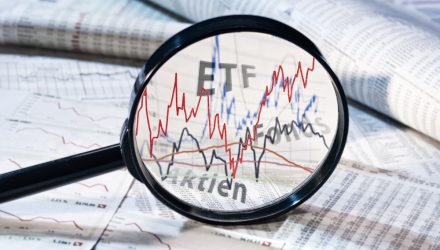During the week, a total of 16 new ETFs debuted on the U.S. markets. These included launches from AllianzIM, ProShares, Split Rock Trading, River1 Asset Management, Rayliant, Strategas, and Alger. However, other firms also rolled out new funds.
Innovator Launches Defined Outcome, Distribution ETFs
Innovator launched three ETFs at the start of the month. Two are defined distribution ETFs that aim to provide a targeted amount of income to investors while protecting against downside losses. All three funds list on the Cboe BZX Exchange and have expense ratios of 0.79%.
The Innovator Premium Income 15 Buffer ETF — April (LAPR) looks to deliver an annualized distribution rate of 6.44% before expenses via monthly payouts. The fund’s strategy uses flexible exchange options on the SPDR S&P 500 ETF Trust (SPY) to achieve its goals. Although LAPR will not see any of SPY’s upside price return, it is exposed to losses in the fund’s price. However, a 15% downside buffer means that, before expenses, LAPR will not experience any of SPY’s losses until they exceed 15%.
The Innovator Premium Income 9 Buffer ETF — April (HAPR) works the same way, except it has a distribution goal of 7.22% and a downside buffer protecting against the first 9% of losses.
The third Innovator fund, the Innovator Equity Defined Protection ETF — 2 Yr to April 2026 (AAPR), also implements FLEX options to deliver the price return of SPY up to a cap of 18.00% before expenses while providing 100% protection against any downside performance. The two “Premium Income” funds have a one-year outcome period, after which they reset. However, AAPR has a two-year outcome period. Investors must hold all three funds for the entire outcome period to receive the full level of upside performance and downside protection.
AllianzIM, Prudential Grow Buffer ETF Families
AllianzIM and PGIM both rolled out buffer funds tied to SPY as well. The AllianzIM U.S. Equity Buffer15 Uncapped Apr ETF (ARLU) offers uncapped positive returns once the fund has exceeded its assigned spread, meaning SPY’s price return must exceed 2.96% before expenses to experience any upside. It also has a downside buffer protecting it from the first 15% of losses. Unlike other buffer funds, the fund has no upside cap once that spread has been exceeded. ARLU has an expense ratio of 0.74% and lists on the Cboe BZX Exchange.
The PGIM US Large-Cap Buffer 12 ETF – April (APRP) is a typical buffer fund in that it offers exposure to upside price performance up to a cap while protecting against a certain amount of downside performance. APRP’s upside cap is set at 16.34% before expenses for its one-year outcome period. It also has downside protection against the first 12% of losses.
Similarly, the PGIM US Large-Cap Buffer 20 ETF – April (PBAP), also tied to the price performance of SPY, allows for upside exposure up to a pre-expenses cap of 13.11% and has a buffer against the first 20% of losses.
APRP and PBAP each have an expense ratio of just 0.50%, significantly cheaper than similar products. Both funds list on the Cboe BZX Exchange.
Even Herd’s New ETF a Long/Short Fund
ETF newcomer Even Herd launched its first fund on the Nasdaq Stock Market. The Even Herd Long Short ETF (EHLS) is actively managed and uses a proprietary algorithm to implement a momentum-based strategy that takes long and short positions in various U.S. listed equity securities. The fund generally looks to offer 100% long exposure to equities. Meanwhile, its short exposure can range from 10% to 60%. Those short positions are typically not covered, according to the prospectus. EHLS has an expense ratio of 1.58%.
Closures
The week also saw several new ETF closure announcements. Two ETFs will cease to trade after the market closes on April 22. They include the ProShares S&P 500 Bond ETF (SPXB) and the IQ U.S. Small Cap ETF (CSML). And the FlexShares ESG & Climate Emerging Markets Core Index Fund (FEEM) will see its last day of trading a day later, on April 23.
Global X also pushed back the date of the last day of trading for the Global X MSCI Next Emerging & Frontier ETF (EMFM) from a date in April to May 17.
One closure was completed during the week, with the VanEck Future of Food ETF (YUMY) having its last trading day on Tuesday.
Other Changes
Several funds underwent material changes during the week. Direxion changed the names of six of its single-stock funds. The firm bumped the leverage on the products from 1.5X to 2X. The new names are as follows:
- Direxion Daily AAPL Bull 2X Shares (AAPU)
- Direxion Daily AMZN Bull 2X Shares (AMZU)
- Direxion Daily GOOGL Bull 2X Shares (GGLL)
- Direxion Daily MSFT Bull 2X Shares (MSFU)
- Direxion Daily NVDA Bull 2X Shares (NVDU)
- Direxion Daily TSLA Bull 2X Shares (TSLL)
Additionally, the FT Vest International Equity Buffer ETF – June (YJUN) changed its name to the FT Vest International Equity Moderate Buffer ETF – June
Global X and iShares also made changes to some of their funds. The Global X Emerging Markets ETF (EMM) changed its name to the Global X Emerging Markets ex-China ETF. And the Global X Data Center REITs & Digital Infrastructure ETF (VPN) got a new name and ticker to become the Global X Data Center & Digital Infrastructure ETF (DTCR).
Finally, the iShares Factors US Growth Style ETF (STLG) changed its name and ticker to the iShares MSCI USA Quality GARP ETF (GARP) and its index from the Russell US Large Cap Factors Growth Style Index to the MSCI USA Quality GARP Select Index.
For more news, information, and analysis, visit VettaFi | ETF Trends.
